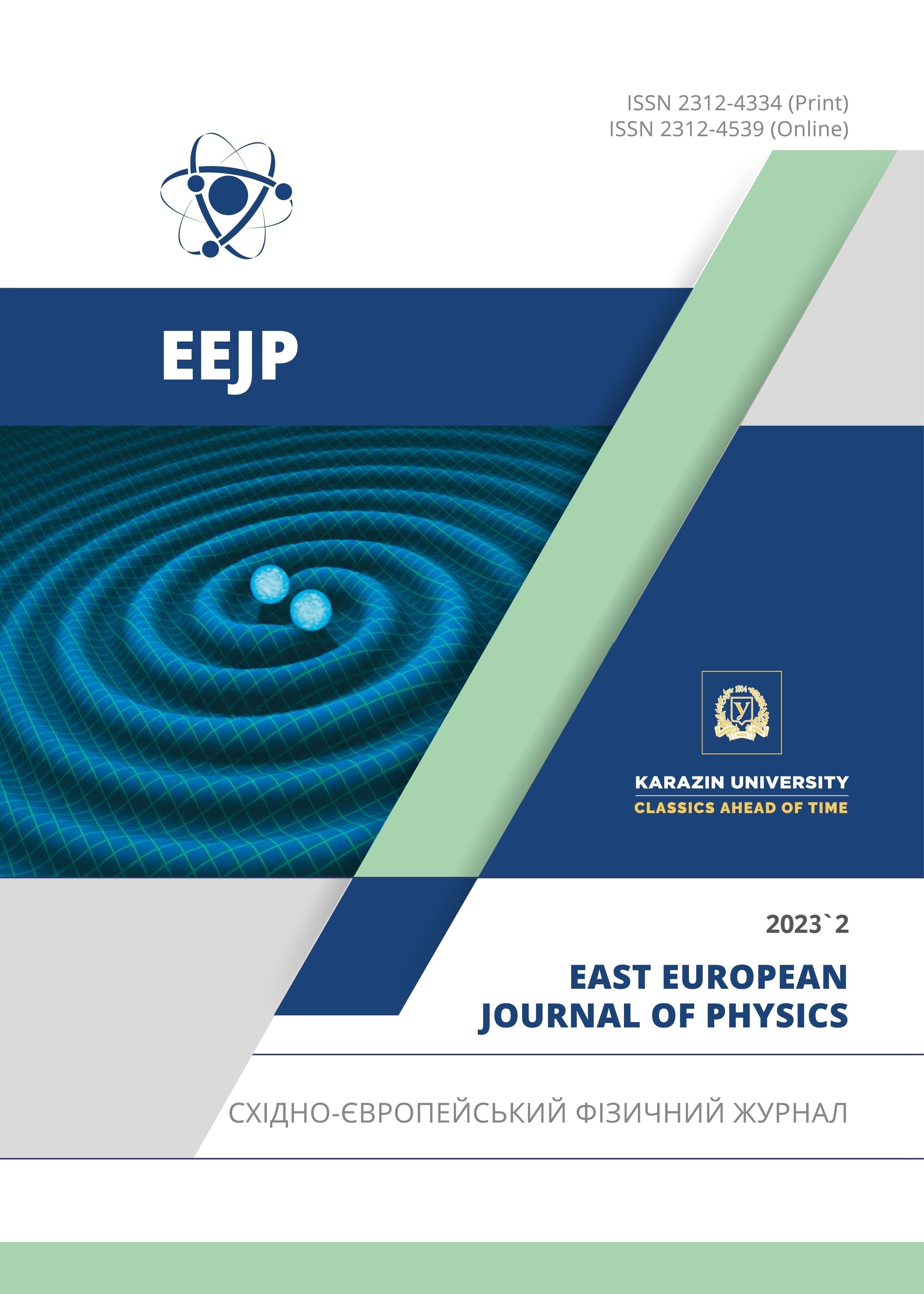Дірково-діркові колективні збудження в ізотопах 106,112,130Sn
Анотація
У цій статті було вивчено схеми енергетичних рівнів нейтронно-насичених і знижених електричних переходів ізотопів олова 106Sn, 112Sn і 130Sn з використанням колективних моделей, тобто hole-hole наближення Тамма-Данкова (hh TDA) і hole-hole апроксимації випадкової фази (hh RPA). Згідно з цими моделями, збуджені стани замкнутих ядер A-2 систем з мультиполярністю J і ізоспіном T можна описати як лінійну комбінацію пар hole-hole (hh). Тому в нашому підході низьколежачі стани досліджуваних ізотопів 106Sn, 112Sn і 130Sn отримані шляхом дії hole-hole операторів на корельоване ядро 108Sn, 114Sn і 132Sn відповідно. Гамільтоніан був діагоналізований у просторі моделі, що включає {1g7/2, 2d5/2, 2d3/2, 3s1/2 and 1h11/2} орбіти, з використанням матричних елементів нейтрон-нейтронної (N-N) взаємодії та модифікованої поверхні дельта взаємодії ( MSDI). hh TDA і hh RPA перевіряються за допомогою результуючих власних значень і власних векторів для розрахунку енергій збудження та зменшених сил електричних переходів. Було проведено порівняння між нашими теоретичними прогнозами та останніми доступними експериментальними даними. У результаті цих порівнянь були отримані розумні згоди.
Завантаження
Посилання
T. Engeland, M. Hjorth-Jensen, A. Holt, and E. Osnes, “Large Shell Model Calculations with Realistic Effective Interaction,” Physica Scripta, 1995(T56), 58 (1995). https://doi.org/10.1088/0031-8949/1995/T56/009
A. Covello, F. Andreozzi, L. Coraggio and A. Gargano, T.T.S. Kuo, and A. Porrino, “Nuclear Structure Calculations With Realistic Effective Interactions”, Progress in Particle And Nuclear Physics, 38, 165 (1997). https://doi.org/10.1016/S0146-6410(97)00023-9
R. Schubart, H. Grawe, J. Heese, H. Kluge, K. H. Maier, and M. Schramm, “Shell Model Structure at 100Sn - the Nuclides 98Ag, 103In, and 104, 105Sn”, Zeitschrift Für Physik A Hadrons And Nuclei, 352, 373-390 (1995). https://doi.org/10.1007/BF01299755
E. Dikmen, “Shell Model Description of Neutron-Deficient Sn Isotopes,” Communications in Theoretical Physics, 51(5), 899 (2009). https://doi.org/10.1088/0253-6102/51/5/28
A. Covello, L. Coraggio, A. Gargano, and N. Itaco, “Shell-model study of exotic Sn isotopes with a realistic effective interaction,” Journal of Physics: Conference Series, 267, 012019 (2011). https://doi.org/10.1088/1742-6596/267/1/012019
T. Trivedi, P.C. Srivastava, D. Negi, and I. Mehrotra, “Shell Model Description of 102−108Sn Isotopes,” International Journal of Modern Physics E, 21(4), 1250049 (2012). https://doi.org/10.1142/S0218301312500498
K.S. Jassim, “Nuclear Structure of 104,106,108Sn Isotopes Using the Nushell Computer Code,” Chinese Journal of Physics, 51(3), 441 (2013). https://cdnx.uobabylon.edu.iq/research/repository1_publication889_30_1533.pdf
K.H.H. Al-Attiah, F.A. Majeed, and T.J. Al-Kawwaz, “Calaculations of Even-Even 100-108Sn Isotopes Using Shell Model in the Vicinity of 100Sn,” Journal of Babylon University/Pure and Applied Sciences, 21(8), 2831(2013). https://iasj.net/iasj/pdf/75f920c6c56d7091
F.A. Majeed, and S.M. Obaid, “Large-Scale Shell Model Calculations of 134,136Sn, 134,136Te around doubly-magic 132Sn”, International Journal of Scientific & Technology Research, 5(4), 106(2016). https://www.ijstr.org/final-print/apr2016/Large-scale-Shell-Model-Calculations-Of-134136sn-134136te-Around-Doubly-magic-132sn.pdf
F.H. Obeed, and B.S. Abed, “Study of energy spectrum of 116Sn and 116Te nuclei by using surface delta and modified surface delta interactions”, Journal of Physics: Conference Series 1664, 012145 (2020). https://doi.org/10.1088/1742-6596/1664/1/012145
A.K. Hasan, F.H. Obeed, and A.N. Rahim, “Positive Parity Levels of 21,23Na Isotopes by Using the Nuclear Shell”, Ukrainian Journal of Physics, 65(1), 3(2020). https://doi.org/10.15407/ujpe65.1.3
S. Akkoyun, “Nuclear Shell Model Calculations for A=49 Isobars”, Turkish Journal of Science and health, 1(2), 3(2020). https://dergipark.org.tr/en/download/article-file/1178106
M.M. Jabbar, and F.H. Obeed, “Description of the energy levels and electric quadrupole transitions of the 92Nb and 92Mo nuclei using nuclear shell model”, Kuwait Journal of Science, 49(2), 1 (2022). https://doi.org/10.48129/kjs.13631
I. Kaplan, Nuclear Physics, (Addison – Wesley Pub.Com. Inc, 1963).
N.D. Cook, Models of the Atomic Nucleus, (Springer -Verlag Berlin Heidelberg Netherlands, 2006).
K.S. Krane, Introductory Nuclear Physics, (John Wiley &Sons, Inc, 1988).
P. Ring, and P. Schuck, The Nuclear Many-Body Problem, (Springer-Verlag, New York, 1980).
J. Suhonen, From Nucleons to Nucleus, (Springer-Verlag, Berlin Heidelberg, 2007).
A.H. Taqi, A.A. Rasheed, and S.H. Amin, “Particle–particle and hole–hole random phase approximation calculations for 42Ca and 38Ca nuclei,” Acta Physica Polonica B, 41(6), 1327 (2010). https://www.actaphys.uj.edu.pl/R/41/6/1327/pdf
A.H. Taqi, “Particle-Particle Tamm-Dancoff Approximation and Particle-Particle Randam Phase Approximation Calculations for 18O and 18F Nuclei,” Pramana Journal of Physics, 80(2), 355-360 (2013). https://doi.org/10.1007/s12043-012-0468-1
A.H. Taqi, “The Electroexcitation of Low-Lying, Collective, Positive Parity, T=1 States in 18O, Based on the Particle-Particle Random Phase Approximation”, Chinese Journal of Physics, 45(5), 530 (2007). https://www.airitilibrary.com/Publication/Index?DocID=05779073-200710-45-5-530-536-a&jsonString=
A.H. Taqi, “A visual Fortran 90 program for the two-particle or two-hole excitations of nuclei: The PPRPA program,” SoftwareX 5, 51-61 (2016). https://doi.org/10.1016/j.softx.2016.04.003
A.H. Taqi, and A.H. Ibrahim, “Collective Excitations of 14N and 10B Nuclei,” Kirkuk University Journal-Scientific Studies, 11(1), 202 (2016). https://doi.org/10.32894/kujss.2016.124396
A.H. Taqi, and A.H. Ibrahim, “Electron scattering of 14N based on two-hole excitations,” Chinese Journal of Physics, 54, 185 193 (2016). https://doi.org/10.1016/j.cjph.2016.04.003
P.J. Brussaard, and P.W. Glaudemans, Shell model applications in nuclear spectroscopy, (Amsterdam: North-Holland, 1977).
National Nuclear Data Center https://www.nndc.bnl.gov
Авторське право (c) 2023 Фахіма А. Сабер, Алі Х. Такі

Цю роботу ліцензовано за Міжнародня ліцензія Creative Commons Attribution 4.0.
Автори, які публікуються у цьому журналі, погоджуються з наступними умовами:
- Автори залишають за собою право на авторство своєї роботи та передають журналу право першої публікації цієї роботи на умовах ліцензії Creative Commons Attribution License, котра дозволяє іншим особам вільно розповсюджувати опубліковану роботу з обов'язковим посиланням на авторів оригінальної роботи та першу публікацію роботи у цьому журналі.
- Автори мають право укладати самостійні додаткові угоди щодо неексклюзивного розповсюдження роботи у тому вигляді, в якому вона була опублікована цим журналом (наприклад, розміщувати роботу в електронному сховищі установи або публікувати у складі монографії), за умови збереження посилання на першу публікацію роботи у цьому журналі.
- Політика журналу дозволяє і заохочує розміщення авторами в мережі Інтернет (наприклад, у сховищах установ або на особистих веб-сайтах) рукопису роботи, як до подання цього рукопису до редакції, так і під час його редакційного опрацювання, оскільки це сприяє виникненню продуктивної наукової дискусії та позитивно позначається на оперативності та динаміці цитування опублікованої роботи (див. The Effect of Open Access).








